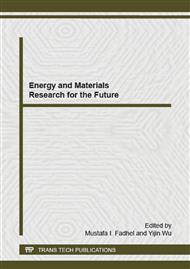[12]
of relationship between the dielectric property and freshness of apples and according to the significant correlation between the storage time and the content of total sugar and acid, it could be concluded that there was significant correlation between the freshness and the content of total sugar and acid. So, it was feasible to use TI to measure the jujube's freshness. The local standard DB64 / T419-(2005).
Google Scholar
[13]
of Ling-Wu long jujubes of Ningxia prescribed that the content of total sugar (measured as sucrose) and acid (measured as malic acid) of qualified matured fresh Ling-Wu long jujubes are 230. 0 g/Kg and 4. 0 g/ Kg respectively. On the basis of this standard, postharvest Ling-Wu long jujubes are divided into three grades according to their freshness. The freshness grades of the Ling-Wu long jujubes are divided as follows: TI≤270 is the first grade, 270<TI≤295 is the second grade and TI>295 is the third grade, which is shown in figure 1 (c). As can be seen in the figure 1 (c), postharvest Ling-Wu long jujubes were basically the first grade during storage of 1~2 days, were basically the second grade during storage of 3~4 days and were basically the third grade during storage of more than 4 days. Results and discussion Determination of characteristic frequency. Polarization phenomenon often occurs when biological tissues are placed in an alternating electromagnetic field. Because the macromolecules of biological tissues need a period of time for changing from non-polarization status into polarization status during the polarization process, there is a relaxation time, and the reciprocal of the relaxation time is the characteristic frequency (Li et al., 2010).
Google Scholar
[1]
Stuart O. Nelson, Forbus W Jr, Lawrence K. (1994) Permittivities of fresh fruits and vegetables at 0. 2 to 20 GHz[J]. Journal of Microwave Power and Electromagnetic Energy, 29(2): 981-932.
DOI: 10.1080/08327823.1994.11688235
Google Scholar
[2]
Raoul R. Nigmatullin, Stuart O. Nelson. (2006)Recognition of the 'fractional', kinetics in complex systems: Dielectric properties of fresh fruits and vegetables from 0. 01 to 1. 8 GHz[J]. Signal Processing, 86(10): 2744-2759.
DOI: 10.1016/j.sigpro.2006.02.018
Google Scholar
[3]
Maria E. Monzon, Bill Biasi, Elizabeth J. Mitcham, et al. (2007)Effect of Radiofrequency Heating on the Quality of Fuyu, Persimmon Fruit as a Treatment for Control of the Mexican Fruit Fly[J]. HortScience, 42(1): 125-129.
DOI: 10.21273/hortsci.42.1.125
Google Scholar
[4]
Kato Koro. (1997) Electrical density sorting and estimation of soluble solid content of watermelon[J]. Journal of Agricultural Engineering Research, 67, 161–170.
DOI: 10.1006/jaer.1997.0160
Google Scholar
[5]
Yuan Zihui, Liao Yulan, Weng Shaojie, et al. (2011)The relationship between dielectric properties and internal quality of mango[J]. Journal of Agricultural Mechanization Research, 10(3): 111-114.
Google Scholar
[6]
NELSON S O, TRAGELSI S, KAYS J. (2006)Dielectric spectroscopy of honeydew melons from 10 MHz to 118 GHz for quality sensing[J]. Transactions of the ASAGE, 49(6): 1977-(1981).
DOI: 10.13031/2013.22278
Google Scholar
[7]
Li Ying, Song Jing-ling, Han Qiuyan. (2007). The relations between the fruit interior quality target and the electricity characteristic of fruit[J]. Journal of Agricultural Mechanization Research, (8): 123-124.
Google Scholar
[8]
Guo Wenchuan, Stuart O. Nelson, Samir Trabelsi, et al. (2008) Radio Frequency(RF) Dielectric Properties of HoneydewMelon and Watermelon Jjuice and Correlations with Sugar content[J]. Transactions of the CSAE, 24(5): 289-292.
Google Scholar
[9]
M. Soltani, R. Alimardani, M. Omid. (2012)Evaluting banana ripening tatus from measuring dielectric properties[J]. Journal of Food Engineering, 105(2011)625-631.
DOI: 10.1016/j.jfoodeng.2011.03.032
Google Scholar
[10]
Zhang Shuihua. (2009) Food Analysis[M](in Chinese). Beijing: China Light Industry Press, 82-128.
Google Scholar
[11]
Marta Castro-Giráldez, Pedro J. Fito, Creu Chenoll, et al. (2010) Development of a dielectric spectroscopy technique for the determination of apple (Granny Smith)maturity[J]. Innovative Food Science and Emerging Technologies, 1(11), 749-754.
DOI: 10.1016/j.ifset.2010.08.002
Google Scholar
[12]
Zhang Libin, Xu Fang, Zhou Guojun. (1996) Study on Correlations Between Dielectric Properties and Freshness of Apples[J]. Transactions of the CSAE, 1996, 12(3): 187-190.
Google Scholar
[13]
Ningxia Bureau of Quality and Technology Supervision. The Standard Assembly of Red Jujubes [M] . Yinchuan: Ningxia People's Education Press, 2013, 7-8.
Google Scholar
[14]
Li Lite. (2010) Physical Properties of Foods[M]. Beijing: China Agriculture Press (in Chinese), 286-287.
Google Scholar


